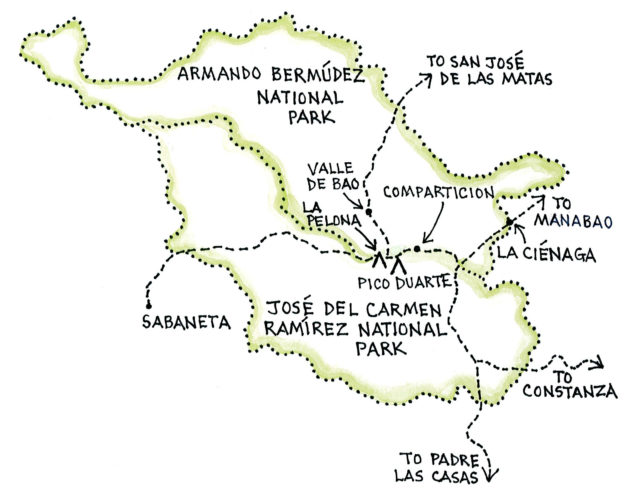Jarabacoa with Armando Bermúdez and José del Carmen Ramírez National Parks
The national parks of Armando Bermúdez (78,957 ha) and José del Carmen Ramírez (76,400 ha) are located on the northern slope of the Cordillera Central in the central portion of the Dominican Republic. These parks protect large stands of pine forest, moist broadleaf forests, montane moist scrub, and intervening transition forests surrounding the highest peaks in the Caribbean, including the 3,087 m Pico Duarte. In addition to spectacular scenery, twelve of the Dominican Republic’s major rivers are spawned in these mountains. Typical bird species found in these twin parks include all of the high elevation endemics, but species that prefer pine forest, such as Hispaniolan Parrot, Hispaniolan Parakeet, Hispaniolan Trogon, Golden Swallow and Hispaniolan Crossbill, are more abundant than those favoring moist broadleaf and cloud forests.
These parks are probably not the best destinations for the ardent birdwatcher, simply because getting into the parks requires substantial planning and a longer commitment of time then many other more easily accessed sites. We include them here, however, because more casual birders may be interested in the trekking opportunities in the area and will therefore be interested in the birds of these national parks. There are a number of interesting hikes and birdwatching opportunities, especially close to the town of Jarabacoa, through which Pico Duarte traffic generally passes. Local communities like Jarabacoa are actively involved in the area’s management and conservation, and considerable income is generated through ecotourism activities such as guided tours. We encourage visitors to take advantage of these diverse opportunities.
Access to the park and its trails is allowed only with a local guide; guides and their necessary mules may be found through organized trips, or you may find independent guides in nearby communities. Trips to Pico Duarte from La Ciénaga usually take three days. The first four kilometers are an easy walk along a shaded stream, but once you begin to climb the trail is steep, deeply eroded, and not particularly blessed with switchbacks. Most of the route traverses pine forests, although the passage of a massive wildfire is much in evidence. Guides are not likely to encourage the slow pace needed for birdwatching, so we would recommend adding a fourth day to your hike with a side trip to the Valle de Tétero. In addition to the other pine specialist birds that you might see, the rare Stygian Owl has also been recorded here.
On the margins of the park, and especially in the Manabao region on your way to La Ciénaga, you will pass through a prominent coffee-growing region in the upper reaches of the valley of the Río Yaque del Norte. These small, shaded plantations are good sites for a wide variety of birds, including Sharp-shinned Hawk, Hispaniolan Emerald, Broad-billed Tody, Greater Antillean Pewee, Bananaquit, Black-crowned Palm-Tanager, and Yellow-faced Grassquit. In season it is also excellent habitat for a number of Neotropical migratory birds, including Cape May Warbler, Black-throated Blue Warbler, Black-throated Green Warbler, Black-and-white Warbler, American Redstart, and Ovenbird.
Other nice birding opportunities are available from your base in Jarabacoa. A conveniently located hiking trail that you may walk on your own is found at El Mogote. This is an isolated peak on the Odulio Jiménez road, just two kilometers outside of Jarabacoa. From the main road, look for the left hand turn that takes you up a short roadway towards a monastery, then look for the steep trail that heads up this hill. A three-hour hike will take you to a nice summit that is dominated by moist broadleaf forests with Narrow-billed Todies, Hispaniolan Trogons, Rufous-throated Solitaire, Red-legged Thrush and Hispaniolan Spindalis.
Hiking to any of the waterfalls in the Jarabacoa area are also highly recommended. The Jimenoa and Baiguate waterfalls are the most popular; hiking to these can offer opportunities to see many forest birds, as well as White-collared Swifts which are frequently found around the falls themselves.
Target species for this site include Sharp- shinned Hawk, Scaly- naped Pigeon, Plain Pigeon, Hispaniolan Parakeet, Hispaniolan Parrot, Hispaniolan Trogon, Loggerhead Kingbird, Golden Swallow, Rufous- throated Solitaire, Red- legged Thrush, Black- throated Blue Warbler, Yellow- throated Warbler, Hispaniolan Spindalis, Rufous- collared Sparrow, Hispaniolan Crossbill, Antillean Siskin.
Being large, central parks, Armando Bermúdez and José del Carmen Ramírez National Parks are adjacent to many small communities. There are five ranger stations at the entrances to five major trails leading to Pico Duarte, but only two are frequently used. We recommend the entrance at La Ciénaga, which itself is reached via the major ecotourism center of Jarabacoa. To reach Jarabacoa you must drive north of Santo Domingo on the Autopista Duarte, the main south-to-north highway. Once you pass the towns of Bonao and La Vega, take the exit to Jarabacoa. This is a winding road with slow-moving trucks so proceed with caution. Nearing Jarabacoa, you will descend on Av. Independencia into a wide montane valley.
You will likely want to spend time in Jarabacoa, but to reach La Ciénaga you continue on Av. Independencia to Calle El Carmen (one block short of Independencia’s conclusion). Turn right, cross the Río Jimenoa (which is not much more than a stream at this point), and turn left on Odulio Jiménez. This road will take you out of Jarabacoa, crossing fertile agricultural fields, passing by El Mogote, then cutting into the hills high above the Río Yaque del Norte. At Manabao look for a well-marked right hand turn, and then continue on to the small village of La Ciénaga, 23 km (14.3 miles) from Jarabacoa.

